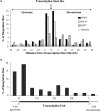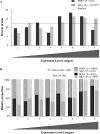Porcine endogenous retrovirus integration sites in the human genome: features in common with those of murine leukemia virus
- PMID: 16928752
- PMCID: PMC1642138
- DOI: 10.1128/JVI.00904-06
Porcine endogenous retrovirus integration sites in the human genome: features in common with those of murine leukemia virus
Abstract
Porcine endogenous retroviruses (PERV) are a major concern when porcine tissues and organs are used for xenotransplantation. PERV has been shown to infect human cells in vitro, highlighting a potential zoonotic risk. No pathology is associated with PERV in its natural host, but the pathogenic potential might differ in the case of cross-species transmission and can only be inferred from knowledge of related gammaretroviruses. We therefore investigated the integration features of the PERV DNA in the human genome in vitro in order to further characterize the risk associated with PERV transmission. In this study, we characterized 189 PERV integration site sequences from human HEK-293 cells. Data showed that PERV integration was strongly enhanced at transcriptional start sites and CpG islands and that the frequencies of integration events increased with the expression levels of the genes, except for the genes with the highest levels of expression, which were disfavored for integration. Finally, we extracted genomic sequences directly flanking the integration sites and found an original 8-base statistical palindromic consensus sequence [TG(int)GTACCAGC]. All these results show similarities between PERV and murine leukemia virus integration site selection, suggesting that gammaretroviruses have a common pattern of integration and that the mechanisms of target site selection within a retrovirus genus might be similar.
Figures




Similar articles
-
The International Xenotransplantation Association consensus statement on conditions for undertaking clinical trials of porcine islet products in type 1 diabetes--chapter 5: Strategies to prevent transmission of porcine endogenous retroviruses.Xenotransplantation. 2009 Jul-Aug;16(4):239-48. doi: 10.1111/j.1399-3089.2009.00544.x. Xenotransplantation. 2009. PMID: 19799764
-
Bovine leukemia virus integration site selection in cattle that develop leukemia.Virus Res. 2011 Mar;156(1-2):107-12. doi: 10.1016/j.virusres.2011.01.004. Epub 2011 Jan 12. Virus Res. 2011. PMID: 21237224
-
Genome areas with high gene density and CpG island neighborhood strongly attract porcine endogenous retrovirus for integration and favor the formation of hot spots.J Virol. 2009 Feb;83(4):1920-9. doi: 10.1128/JVI.00856-08. Epub 2008 Nov 26. J Virol. 2009. PMID: 19036816 Free PMC article.
-
No in vivo infection of triple immunosuppressed non-human primates after inoculation with high titers of porcine endogenous retroviruses.Xenotransplantation. 2009 Jan-Feb;16(1):34-44. doi: 10.1111/j.1399-3089.2009.00508.x. Xenotransplantation. 2009. PMID: 19243559
-
Recombinant porcine endogenous retroviruses (PERV-A/C): a new risk for xenotransplantation?Arch Virol. 2008;153(8):1421-6. doi: 10.1007/s00705-008-0141-7. Epub 2008 Jun 27. Arch Virol. 2008. PMID: 18584115 Review.
Cited by
-
Integration site preference of xenotropic murine leukemia virus-related virus, a new human retrovirus associated with prostate cancer.J Virol. 2008 Oct;82(20):9964-77. doi: 10.1128/JVI.01299-08. Epub 2008 Aug 6. J Virol. 2008. PMID: 18684813 Free PMC article.
-
Cardiac xenotransplantation: a promising way to treat advanced heart failure.Heart Fail Rev. 2022 Jan;27(1):71-91. doi: 10.1007/s10741-020-09989-x. Heart Fail Rev. 2022. PMID: 32572737 Review.
-
Porcine Endogenous Retrovirus (PERV) - Molecular Structure and Replication Strategy in the Context of Retroviral Infection Risk of Human Cells.Front Microbiol. 2018 Apr 11;9:730. doi: 10.3389/fmicb.2018.00730. eCollection 2018. Front Microbiol. 2018. PMID: 29755422 Free PMC article. Review.
-
Complete Genome Sequence of a Porcine Endogenous Retrovirus Isolated from a Bama Minipig in Guangxi, Southern China.Genome Announc. 2015 Jun 11;3(3):e00620-15. doi: 10.1128/genomeA.00620-15. Genome Announc. 2015. PMID: 26067965 Free PMC article.
-
Porcine endogenous retroviruses in xenotransplantation--molecular aspects.Viruses. 2014 May 13;6(5):2062-83. doi: 10.3390/v6052062. Viruses. 2014. PMID: 24828841 Free PMC article. Review.
References
-
- Bushman, F., M. Lewinski, A. Ciuffi, S. Barr, J. Leipzig, S. Hannenhalli, and C. Hoffmann. 2005. Genome-wide analysis of retroviral DNA integration. Nat. Rev. Microbiol. 3:848-858. - PubMed
-
- Bushman, F. D. 2003. Targeting survival: integration site selection by retroviruses and LTR-retrotransposons. Cell 115:135-138. - PubMed
Publication types
MeSH terms
LinkOut - more resources
Full Text Sources
Other Literature Sources
Miscellaneous

